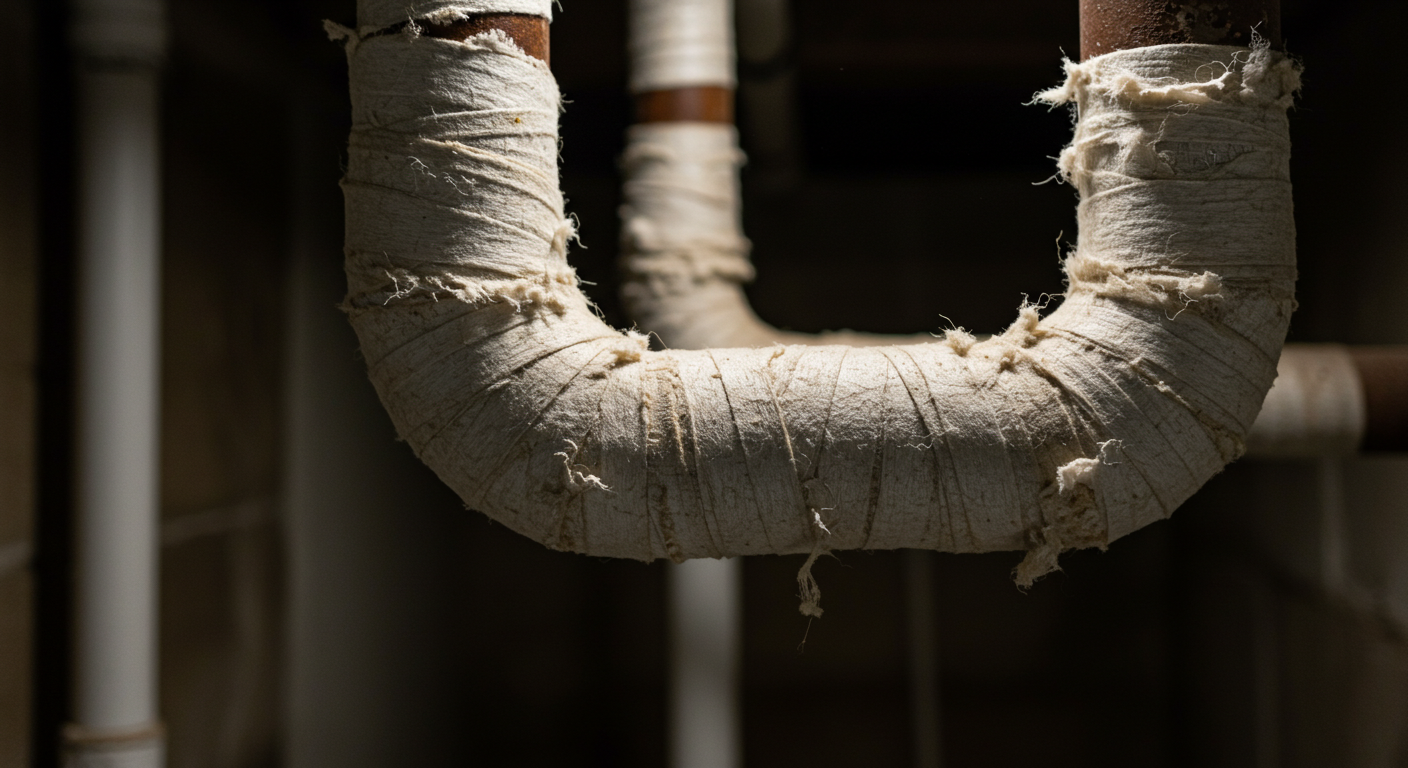Have you encountered the term ‘asbestlint’ and felt a sense of unease? You are not the only one. The word itself can be confusing because it refers to two very different items: a modern safety product and a historical hazardous material often found in older buildings.
Understanding the Confusion Around Asbestlint
Understanding the difference is the most critical step toward ensuring your safety and peace of mind. This guide will eliminate the confusion and help you make informed decisions. We will explain what asbestlint means in both contexts and provide a clear, step-by-step action plan for homeowners in the Netherlands and Belgium. After reading, you will have the knowledge to handle your situation with confidence and caution.
Modern Asbestlint: A Sign of Professional Safety
What Does It Look Like?
If you have seen yellow-and-black striped tape at a construction site, you can relax. This type of asbestlint is a modern safety tool, not a health hazard itself. It looks much like crime scene tape but is used for construction and asbestos abatement sites where strict regulation is enforced.
What Is Its Purpose?
Professionals use this tape to clearly mark the boundaries of an area where asbestos is being removed or managed. Its purpose is simple yet crucial: to prevent anyone without authorization or proper personal protective equipment (PPE) from entering a contaminated zone. You will often see it printed with text like “ASBEST – GEEN TOEGANG” (ASBESTOS – NO ENTRY) to warn the public.
What Should You Do If You See It?
The presence of this tape means a regulated, professional asbestos project is in progress. In the Netherlands, this work is monitored by the Netherlands Labour Authority (Nederlandse Arbeidsinspectie), while in Belgium, regional bodies like the FPS Employment, Labour and Social Dialogue oversee these activities. The best and only thing to do is respect the barrier and stay out of the marked area to avoid any accidental exposure.
The Hidden Danger: Historical Asbestos Insulation Tape
A Legacy of the “Magic Mineral”
Now, we turn to the older form of asbestlint: the insulation tape that might be in your home. This material is a relic from an era when asbestos was hailed as a “magic mineral” for its fire resistance, thermal properties, and insulating power.
From the 1950s through the 1980s, it was widely used to insulate hot water pipes and HVAC systems in homes across Europe. The Benelux region, including the Netherlands and Belgium, was a major center for asbestos use, making these materials common in older local properties, especially those built before modern regulations were introduced.
Where to Find Old Asbestos Tape in Your Home
You are most likely to find this tape in non-living spaces like basements, attics, and crawl spaces that have not been renovated. Check the ductwork connected to your furnace or boiler, especially at the joints and elbows where insulation was often applied. Old hot water or steam pipes are another common location. If your home was built before 1994, these areas are of primary concern and should be inspected cautiously.
How to Visually Identify Suspected Asbestos Tape
You cannot confirm asbestos just by looking at it; only a lab test can be certain. However, you can look for clues to decide if you need a professional inspection or further testing.
Historical asbestos tape is usually a non-reflective white, off-white, or grayish color. It has a matte finish and a texture that can look like thick paper, woven cloth, or even a plaster-like cast molded around pipe joints and fittings. These indicators can help you determine whether to seek expert advice.
The Importance of Professional Confirmation
Because many non-asbestos materials can look similar and may even mimic asbestos in texture, visual identification is not enough. A certified professional should take a sample for laboratory analysis to give you a definitive answer. This is the only reliable and safe way to know for sure whether you are dealing with asbestos.
Understanding the Health Risks
What Makes Asbestos Tape Dangerous? The Concept of “Friability”
The danger of historical asbestos tape comes from a property called “friability.” A material is friable if it can be easily crumbled or reduced to powder by hand pressure. Over time, the binding agents in asbestos tape degrade, making it brittle and friable, especially in humid or high-traffic environments.
How Asbestos Fibers Harm the Body
When this material is disturbed—by being bumped, scraped, or simply deteriorating—it releases microscopic, needle-like fibers into the air. These fibers are invisible, odorless, and can stay airborne for hours or even longer. If inhaled, they can lodge permanently in the lungs, causing inflammation and scarring that can lead to severe diseases decades later.
Serious Health Conditions Linked to Asbestos
Long-term exposure to asbestos fibers increases the risk for several serious conditions:
Asbestosis: A progressive scarring of the lungs that makes breathing difficult over time.
Lung Cancer: The risk of lung cancer is significantly higher after asbestos exposure, especially for smokers who are doubly vulnerable.
Mesothelioma: A rare and aggressive cancer of the lining of the lungs, abdomen, or heart, almost exclusively caused by asbestos exposure.
A Note on Exposure: Intact vs. Disturbed Material
It is crucial to remember that the primary danger comes from disturbance. If the tape is intact, solid, and in a location where it will not be touched, the immediate risk is low. The goal is to keep it that way until a professional can assess it for safety and potential remediation.
Found Suspected Asbestos Tape? A Step-by-Step Action Plan
Step 1: Do Not Panic and Do Not Disturb
This is the most important rule. The biggest risk comes from releasing fibers into the air through disturbance.
DO NOT touch, scrape, sand, or cut the material.
DO NOT try to peel it off for a closer look.
DO NOT vacuum the area with a standard vacuum cleaner.
DO limit access to the area. Keep children and pets away to avoid accidental contact.
Step 2: Assess the Condition from a Safe Distance
Look at the material without touching it or disturbing the surrounding environment. Is it in good, solid condition, or is it damaged, flaking, or crumbling? This information will help the professional you call to understand the urgency and plan accordingly.
Step 3: Contact a Certified Professional
For friable materials like old insulation tape, DIY removal is strongly discouraged and often illegal in regulated countries. The risk of contaminating your home is too high. Hiring a certified professional is the only safe and lawful option.
Hiring Certified Professionals: Netherlands and Belgium
Finding a Certified Professional in the Netherlands
You must use a certified asbestos abatement company (gecertificeerd asbestsaneringsbedrijf). You can find a list of these companies in the official Ascert register. A demolition notification (sloopmelding) must be filed with your municipality, usually through the Omgevingsloket for legal compliance.
Finding a Certified Professional in Belgium
In Flanders, regulations are managed by the Public Waste Agency of Flanders (OVAM). For properties built before 2001, an asbestos certificate (asbestattest) is mandatory for sales and will be required for all such properties by 2032. This inventory must be prepared by a certified expert registered with OVAM.
Key Questions to Ask Your Asbestos Contractor
To ensure you hire a qualified professional, ask these important questions:
Can you provide proof of your certification and past work?
How will you contain the work area to prevent contamination?
What is your process for waste disposal and transportation?
Will you conduct air quality testing after the work is complete?
Can you provide a detailed, written contract and timeline?
Your Options: Encapsulation or Removal?
What is Encapsulation?
Encapsulation involves applying a special, thick sealant that coats the asbestos material. This sealant binds the fibers together, preventing them from becoming airborne and reducing risk.
Pros and Cons of Encapsulation
Encapsulation is best for asbestos that is in good condition and unlikely to be disturbed. It is generally less expensive and less disruptive than removal. However, it is not a permanent solution, as the asbestos remains in place and must be monitored.
What is Professional Removal?
Removal, or abatement, involves certified professionals setting up a full containment area and safely removing all asbestos material. The waste is then disposed of according to strict regulations and legal standards.
Pros and Cons of Removal
Removal is the best option for damaged, friable tape or if you are planning a major renovation. It permanently eliminates the hazard and provides complete peace of mind. However, it is more expensive, time-consuming, and disruptive to the home environment.
Which Option is Right for You?
The right choice depends on the condition of the asbestos tape, your budget, and your future plans for the property. A certified contractor can provide a professional recommendation based on a thorough inspection and risk assessment.
Safe and Modern Insulation Alternatives
Fiberglass Tape
Fiberglass tape is a common and effective substitute. It offers excellent thermal resistance without the health risks of asbestos, making it ideal for modern heating and cooling systems.
Silicone Tape
Known for its flexibility, durability, and high heat resistance, silicone tape is another versatile and safe option for many applications involving insulation or sealing.
Aramid (Kevlar®) Fiber Tape
For applications that require extreme strength and temperature resistance, aramid fiber tapes provide a high-performance, safe solution. These are used in aerospace, automotive, and industrial settings.
Conclusion: From Confusion to Confidence
The term asbestlint can be confusing, but it doesn’t have to be a source of fear or uncertainty. By understanding its two distinct meanings—modern warning tape versus historical insulation—you have already taken the most important step toward safety.
If you see the yellow-and-black tape, you know that professionals are managing a situation safely. If you find old, white or gray insulation tape, remember the golden rule: don’t panic and don’t disturb it. By leaving the material alone and contacting a certified professional, you are choosing the safest path forward. With the right knowledge and expert help, you can handle this challenge confidently and keep your home safe for years to come.

